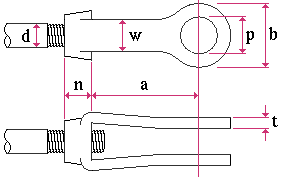The Clevis Material window ( Modeling )
- See (on another page): Adding a clevis material or legacy miscellaneous member .
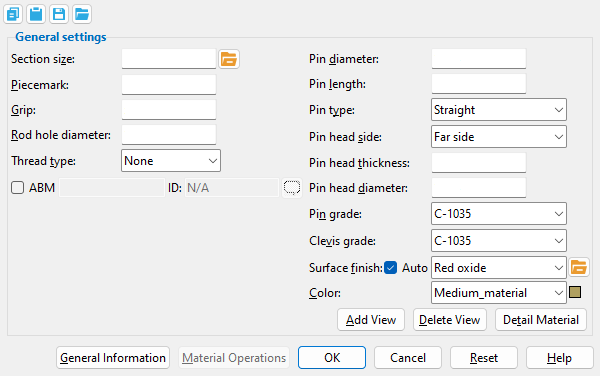
- When a legacy miscellaneous member is first added, Add [Legacy] Miscellaneous Member options are shown on this window.

- To open this window (in Modeling ):
- Add a clevis material or legacy miscellaneous member
- Edit Material ( Modeling -- one material, with change options)
- Edit Multiple Materials (no change options)
- Right-click (Menu) and choose " Edit " ( Modeling )
- Double-click the material -- not main material ( Modeling )
- Review 2D Items (non-editable, Drawing Editor )
Also see :
- Clevis (topic)
- Clevis miscellaneous material
- Brace Connection To Gusset (leaf containing rod brace locks)
- Rod bracing (Connection Guide)
- Dimension precision (sets precision for distance entries)
- General Information window (accessible from this window)
- Submaterial piecemark (each unique material identified by)
- Submaterial detail (2D drawing of a material)
- Grayed out fields (indicate mixed entries or that the field is disabled)
- Altering a legacy miscellaneous member's main view
 " Copy " " Paste " " Save " " Load " buttons :
" Copy " " Paste " " Save " " Load " buttons :
------ General settings ------
Section size: Any clevis material section size that is listed in the local shape file . You must enter a section size in order to complete the adding of a material or a legacy miscellaneous member operation.
|
To enter a section size: You can type in the section size that you want, or you can press the "file cabinet" browse button (
) and double-click a section size from the list of available clevis material. If the section you enter does not exist in the local shape file, validation prompts you to make a different entry.
Also see: Changing the " Section size " affects the " Description ," " Weight of item " and " Surface area " on the material's General Information window. After detailing, it also affects the " Description " and " Unit Weight " fields on the member bill of material.
Connection Design Locks: Brace Connection To Gusset
Report Writer: MemberMaterial.Material.SubMaterial.MaterialFile.SectionSize
Piecemark: Blank or any character string (up to 61 characters). This is the submaterial piecemark .
If this field is left ' blank ', then when this material is generated (after you press " OK "), piecemarking looks for materials in the current Job that are physically identical to this material and assigns to this material the same mark assigned to those materials. If no matching materials are found, piecemarking assigns this material a piecemark using the appropriate piecemark prefix listed in Home > Project Settings > Fabricator > Member and Material Piecemarking > the " Prefixes " tab.
Any ' character string ' that you enter must be unique. Validation does not let you enter a piecemark that has already been assigned to materials. If you are adding a clevis material or legacy miscellaneous member, a piecemark entered here only applies if the material you are adding is unique -- if the material is exactly the same as previously added materials, the new material gets the piecemark of those previously added materials. On the other hand, if you are editing the material, all materials that are exactly like the material are re-assigned the unique mark you enter when the material is generated (after you press " OK "). The piecemark you enter remains a system piecemark , which means that it may be changed if you later edit a material just like this one and give that material a different piecemark.
Tip: If you want to change a submaterial mark, you should use Rename Project Items in Utility Options . That way all references to the submaterial mark are changed throughout the your current Job, even in Drawing Editor drawings.
Note: A submaterial mark is not yet assigned when this window opens for an add material or add legacy miscellaneous member operation. A piecemark is shown when you Edit Material or Review 2D Items . For the current quantity of materials assigned this piecemark, see the " Current quantity " listed on this material's General Information window.
Report Writer: MemberMaterial.Material.MinorMark
Advanced Selection: MinorMark
Parametric module: MinorMark
Grip: The distance (in the primary dimension " Units " or other units ) between the prongs of the clevis.
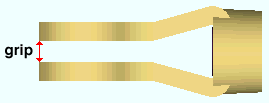
Connection Design Locks: Brace Connection To Gusset
Report Writer: XXXXX . Grip
Advanced Selection: Grip
Parametric module: Grip
Rod hole diameter: The diameter (in the primary dimension " Units " or other units ) of the hole for inserting the rod. If you enter a diameter that is greater than the " Maximum tap diameter " set in the local shape file for the currently selected " Section size ," the resulting rod hole is the diameter in the local shape file.
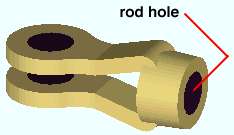
Report Writer: XXXXX . RodDiameter
Advanced Selection: RodDiameter
Parametric module: RodDiameter
Thread type: None or Left handed or Right handed . If the end of the round bar that is to be fitted to this clevis uses ' Left handed ' as its " Thread type ," you will probably want to select ' Left handed ' here.
Connection Design Locks: Brace Connection To Gusset
Round Bar Material: Thread type
Turnbuckle Material: Left thread type and Right thread type
Report Writer: XXXXX . LeftThreadType
Pin diameter: The diameter of the shaft of the clevis pin (in the primary dimension " Units " or other units ). If you enter a diameter that is greater than the " Maximum pin diameter " set in the local shape file for the currently selected " Section size ," the resulting pin diameter is the diameter set in the local shape file.
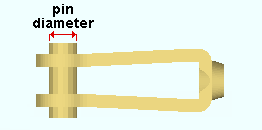
Connection Design Locks: Brace Connection To Gusset
Report Writer: XXXXX . PinDiameter
Advanced Selection: PinDiameter
Parametric module: PinDiameter
Pin length: The distance (in the primary dimension " Units " or other units ) from one end of the clevis pin to its opposite end. The length of the pin includes its head.
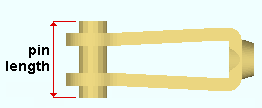
Connection Design Locks: Brace Connection To Gusset
Pin type: Straight or Headed or None .
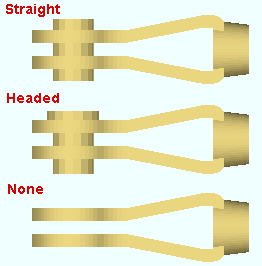
Also see " Pin type "
' Straight ' specifies a clevis pin that is a consistent diameter along the entirety of its " Pin length ."
' Headed ' specifies a clevis pin with a head placed on the selected " Pin head side ." The size of the head is controlled by the entries made to " Pin head thickness " and " Pin head diameter ."
Pin head side: Near side or Far side .
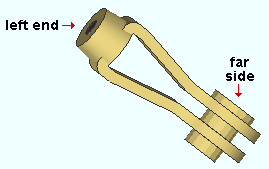
' Near side ' puts the head on the far-side end of the clevis pin.
' Far side ' puts the head on the near-side end of the clevis pin.
Pin head thickness: The distance (in the primary dimension " Units " or other units ) along the length of the pin that you want the " Pin head diameter " to apply when ' Headed ' is selected as the " Pin type ."
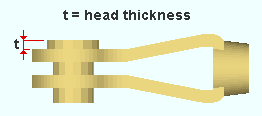
Connection Design Locks: Brace Connection To Gusset
Pin head diameter: The diameter of the pin head (in the primary dimension " Units " or other units ) when ' Headed ' is selected as the " Pin type ."
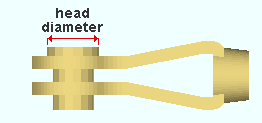
Connection Design Locks: Brace Connection To Gusset
Pin grade: C-1035 or F22 Class3 or etc. This is the grade of steel for the clevis pin.
Setup: If the grade of steel you want is not shown as a list box (
) for this field, you can use Home > Project Settings > Job > Turnbuckle / Clevis / Pin Grades to add it to this list.
Note: Connection design of rod bracing uses the Fy and Fu values entered at Home > Project Settings > Job > Turnbuckle / Clevis / Pin Grades when evaluating the strength of a pin.
Connection Design Locks: Brace Connection To Gusset
Advanced Selection: MaterialGrade
Parametric module: MaterialGrade
Clevis grade: C-1035 or F22 Class3 or etc. This is the grade of steel for the clevis.
Setup: If the grade of steel you want is not shown as a list box (
) for this field, you can use Home > Project Settings > Job > Turnbuckle / Clevis / Pin Grades to add it to this list.
Bill of material: Steel Grade
Advanced Selection: MaterialGrade
Parametric module: MaterialGrade
Surface finish: None or Sandblasted or Red oxide or Yellow zinc or Gray oxide or Blued steel or Galvanized or Duplex Coating or Undefined 1 or Undefined 2 or Undefined 3 or Red oxide 2 or Any user added surface finish. This affects the colors of Solid members on erection views in the Drawing Editor . This also sets the color when Output material color is set to Surface finish for a VRML Export or a DWG/DXF Export. The Color (not Surface finish) sets the color of this material in Modeling .
| sand blasted | red oxide | yellow zinc | user surface finish 1 |
| gray oxide | blued steel | galvanized | user surface finish 2 |
To assign a different surface finish, you can drop-down the current surface finish and select the one you want, or you can press the
browse button and double-click any surface finish that is on the list.
Auto ![]() or
or ![]()
If this box
is checked, the material surface finish follows what is set on the member level.
If the box
is not checked, the material surface finish can be changed to whatever is available in the list of surface finishes. If the surface finish changes from what the member level has set, the auto checkbox will be unchecked automatically. When the auto check box is unchecked, the member edit window shows an information tag which notifies the user that an attached material is not following what was set on the member level.
Note 1: Submaterial piecemarks can be split apart by surface finish. All surface finishes that do not have the Break Marks Material checked on can be applied to any like material with out the material splitting. If the Break Marks Material is checked on then only like materials with that specific surface finish can have the same piecemark, and because the submaterial marks differ so would the member's piecemark.
Note 2: When exporting a KISS file using "model" as the Data source surface finish data on the materials are compiled into the KISS download as follows, with a few exceptions (G=galvanized, N= none or sandblasted, P= others). Those exceptions are:
If the box for Finish routing in KISS export setup is set to a user routing
If the user has adjusted the Abbreviation for any of the default provided surface finishes
If you are using a user added surface finish
In these cases you will get what is provided in either the User routing, or the abbreviation field. For other exports it will always provide the abbreviation in the 'surface finishes' settings page.
Tip 1: Surface area is reported on the General Information window -- and this can be used to estimate the amount of coating required and its cost.
Tip 2: Changing Steel grade, Color, and Surface finish do not cause the plate to be regenerated. This means that, if you change those settings only, material fit operations such as a Fit Exact may optionally be preserved.
Report Writer: MemberMaterial.Material.SurfaceFinish
Setup: Surface Finish Settings
Color: A predefined color or a Custom Color . This is the approximate color of the clevis when it is displayed in one of the three solid forms .
The predefined colors are set up on the Predefined Colors window. The color swatch next to the list box (
) displays the color that is selected.
Select ' Custom Color ' (last choice on the list) to launch your operating system's color picker and define any color you like.
Tip 1: Different colors may be assigned to materials that have the same submaterial piecemark .
Tip 2: Changing " Color " and " Surface finish " do not cause the material to be regenerated. This means that, if you change those settings only, material operations such as a Cut on Plane may, optionally, be preserved.
Report Writer: MemberMaterial.Material.MaterialColor3dRed
Report Writer: MemberMaterial.Material.MaterialColor3dGreen
Report Writer: MemberMaterial.Material.MaterialColor3dBlue
| Special Buttons for Detailing this Material (these do not appear for Add operations) |
||
|
|
|
|
| This button opens a window with a list of preset views . Each preset view that you select on this list is drawn on the submaterial detail when you Detail Submaterial . | This button opens a list of views you can delete. If the material has only one view, you get a warning instead of a list of views since you cannot delete the current view. | This button does a Detail Submaterial on this material. Newly added views are drawn on the detail. Deleted views are not drawn. |
To close this window :
" General Information " opens the General Information window, which provides additional information and settings that pertain to this clevis.
Tip: You can use the General Information window to change the material's " X ," " Y ," or " Z " global coordinates (and thus reposition the material within the 3D model).
Also: A " Properties " button at the bottom of the General Information window lets you Edit Properties for this material.
"OK" (or the Enter key) closes this window and applies the settings on it to the material(s).
If this window opened for adding a material or a legacy miscellaneous member, you can still press " Cancel " on the Rotate Material window to end the add operation.
If you opened this window to edit a single clevis ( single-edit ), the Change All Options & Warning List opens after you press " OK ." You can use that window to cancel your changes or, if other materials with the same submaterial piecemark exist, apply your changes to those other materials.
If you opened this window to edit multiple clevises ( multi-edit ), the Change All Options & Warning List does not open after you press the " OK " button.
"Cancel" (or the Esc key or the ![]() button) closes this window without saving any changes made to it.
button) closes this window without saving any changes made to it.
Possibilities: If you are adding a new material or a legacy miscellaneous member, " Cancel " brings you back to the work point location step in the add operation. For an edit material operation, " Cancel " ends the operation.
"Reset" undoes all changes made to this window since you first opened it. The window remains open.
Note: The settings shown on this window when it first opens for the adding of a material or legacy miscellaneous member are the settings of the last-added or last-edited clevis.
